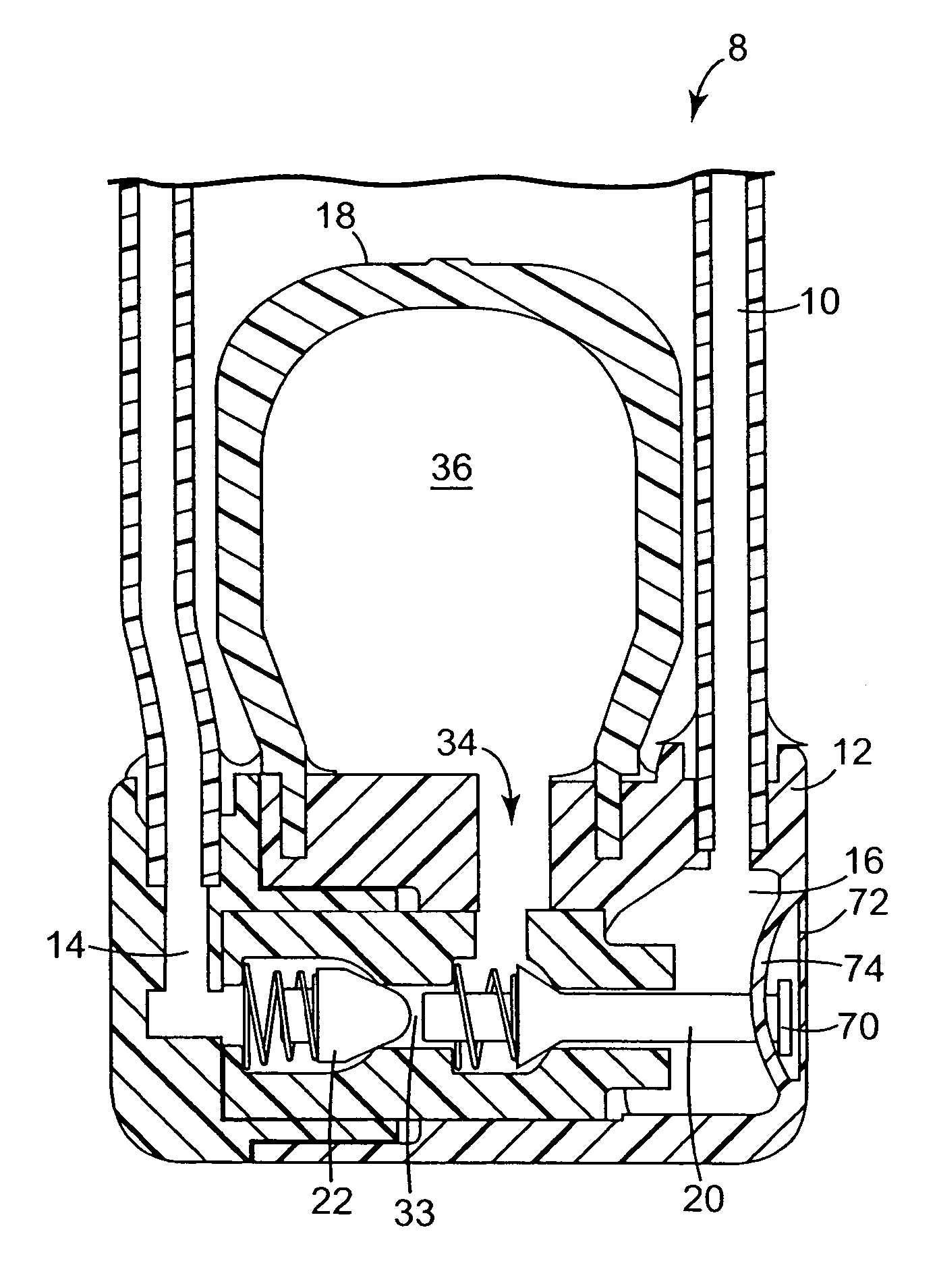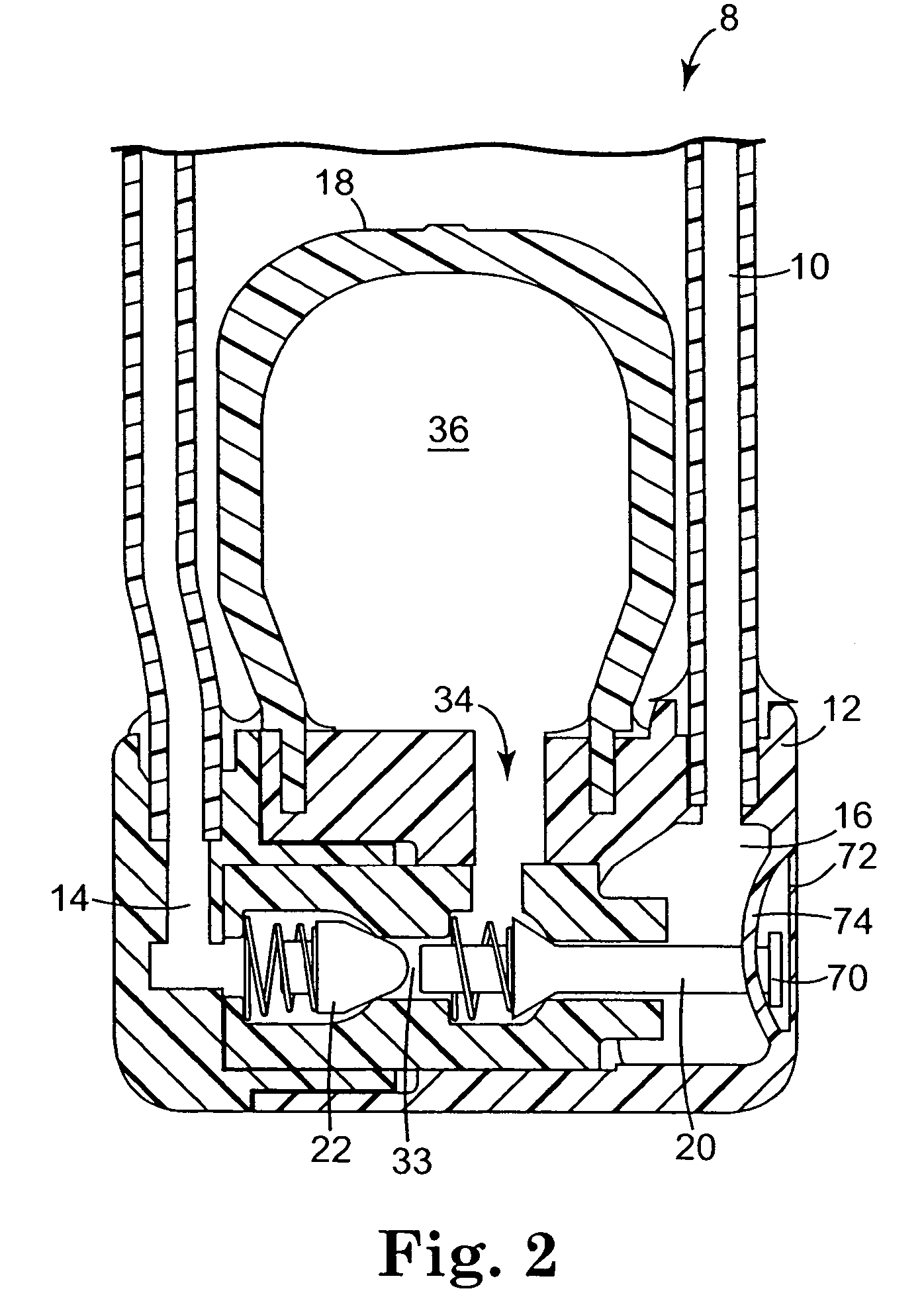Pressure based spontaneous inflation inhibitor with penile pump improvements
a technology of pressure-based mechanisms and spontaneous inflation, which is applied in the direction of medical science, non-surgical orthopedic devices, thin material processing, etc., can solve the problems of increasing the fluid pressure which is transferred to the inflatable cylinder, and the pressure generated by compressing the pump bulb will far exceed the level of overpressure, so as to increase the surface area and reduce the pressure. , the effect of increasing the surface area
- Summary
- Abstract
- Description
- Claims
- Application Information
AI Technical Summary
Benefits of technology
Problems solved by technology
Method used
Image
Examples
first embodiment
[0081]Referring to FIG. 2, the present invention is illustrated. A fluid input 10 couples a reservoir to reservoir chamber 16. Reservoir poppet 20 has been modified to include a T-shaped tip 70. Tip 70 is secured to an outer reservoir chamber wall 72. Tip 70 is secured to the outer reservoir chamber wall by one or more connecting bands 74. Sufficient freedom of movement for reservoir poppet 20 is provided so that during normal operation reservoir poppet 20 can be dislodged from its abutment with reservoir poppet valve seat 24.
[0082]During an overpressure situation, the reservoir is compressed, pressurizing the fluid and directing it through fluid input 10 and into reservoir chamber 16. Outer reservoir chamber wall 72 has been made sufficiently flexible so that when this occurs, reservoir chamber 16 is caused to expand due to the increased pressure generated. As outer reservoir chamber wall 72 expands, connecting bands 74 coupled with tip 70 pull reservoir poppet 20 tightly against r...
second embodiment
[0084]Referring to FIG. 4, the present invention is illustrated. FIG. 4 illustrates the portion of housing 12 containing reservoir poppet 20 and cylinder poppet 22. Reservoir poppet 20 is an elongated member that terminates in a nose 82. A tapered reservoir passageway 84 is provided through a sidewall 80 located adjacent to fluid input 10. Located at the junction of the sidewall 80 and reservoir passageway 84 is a flap 78 that is able to flex, with respect to sidewall 80. Flap 78 is simply the terminus of sidewall 80 at the passageway 84, and will optimally be offset by some angle from the remainder of the sidewall 80.
[0085]As illustrated in FIG. 4, reservoir poppet 20 is in a sealed position. That is, fluid is not able to pass from fluid input 10 through tapered passageway 84 and beyond, because reservoir poppet 20 is sealed against sidewall 80 at reservoir poppet valve seat 24 and is held in place by spring 28. In addition, nose 82 of reservoir poppet 20 contacts flap 78, providin...
third embodiment
[0088]Referring to FIG. 5, a third embodiment is illustrated. Reservoir poppet 20 is an elongated member that extends from common passageway 33, through poppet passageway 92 and into fluid input 10. As with many of the above embodiments, in one position the reservoir poppet 20 abuts reservoir poppet valve seat 24. Similarly, reservoir poppet 20 is only expected to be removed from valve seat 24 during a re-expansion of a compressed pump bulb 18. To prevent the removal of the reservoir poppet from valve seat 24 during an overpressure situation, relief area 90 has been formed within the housing 12. Formation of relief area 90 creates a flexible valve 88. Flexible valve 88 forms a part of the reservoir poppet valve seat 24, and appears as shown in FIG. 5, under normal circumstances.
[0089]FIG. 6 illustrates an overpressure situation where the pressure of the fluid in fluid input 10 and poppet passageway 92 is relatively high. Rather than forcing reservoir poppet 20 from valve seat 24, th...
PUM
 Login to View More
Login to View More Abstract
Description
Claims
Application Information
 Login to View More
Login to View More - R&D
- Intellectual Property
- Life Sciences
- Materials
- Tech Scout
- Unparalleled Data Quality
- Higher Quality Content
- 60% Fewer Hallucinations
Browse by: Latest US Patents, China's latest patents, Technical Efficacy Thesaurus, Application Domain, Technology Topic, Popular Technical Reports.
© 2025 PatSnap. All rights reserved.Legal|Privacy policy|Modern Slavery Act Transparency Statement|Sitemap|About US| Contact US: help@patsnap.com



